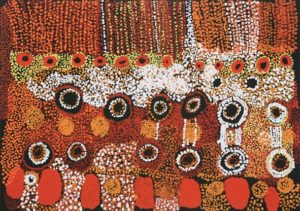
Flinders University Australian Studies senior lecturer Dr Christine Nicholls has curated two exhibitions of Indigenous art, which she escorted to eastern Europe to meet a new audience.
One of the touring exhibitions, comprising 15 Warlpiri, Kukatja and Ngardi prints from Central Australia and the Western Desert, acknowledges Croatia’s 2013 entry into the European Community and opened in Zagreb on January 26 to coincide with Australia Day.
A second exhibition of 10 large prints shown in Belgrade, Serbia, featured images by elderly Pitjantjatjara Yankunytjatjara desert artists who belong to the Tjungu Palya collective in northern South Australia.
Dr Nicholls presented lectures and workshops on aspects of Australian culture, including Indigenous art and languages, in both cities.
The Australian Government funded both exhibitions.
While the underpinnings of Aboriginal art are very different from those of Western art, Dr Nicholls said there were some parallels with religious art, particularly in the importance of narrative context. Knowing the gospel stories, for instance, is crucial in making sense of the Christian art of the renaissance, Dr Nicholls said.
“If you don’t know the significance of the Last Supper, Leonardo’s most famous painting could be interpreted from today’s perspective as a bunch of 13 blokes, wearing frocks, waiting for their dinner,” Dr Nicholls said.
She said background information is needed to avoid the twin dangers of “dumbing down” and disrespect.
“People need to understand that there is a narrative basis to all these artworks, as there is to Christian and other religious artworks,” Dr Nicholls said.
Australian Indigenous art already has a significant following in Europe, notably in Germany, France and Scandinavia.
“The interest is there – people have an appetite for knowing about it.” Dr Nicholls said.
“Aboriginal art is something that can be seen as celebratory not only of Indigenous Australia, but of all of Australia.
“This is true art of Australia – it’s the only one in this country that has a differential cachet, and it’s also the most recent of the world’s great art movement, akin those which changed humans’ ‘ways of seeing’ in Europe and Asia. It is arguably Australia’s greatest cultural gift to the world.”


That was a real pleasure! I live in Belgrade, and had heard there was some ‘desert art’ being exhibited. I imagined something from further north, so kind of neglected to make any plans to drop by and have a look. Which would have been a tragedy, as I lived 10 years at Ernabella, Amata, Pipalyatjara and Umuwa, and was completely shocked and delighted when I arrived and saw I knew each of the artists. I was particularly chuffed to see David’s work – he is my age, more or less, and I remember him from the late 80s – it is nice to see him looking so venerable. I would have loved to have purchased some of the works. Thanks.